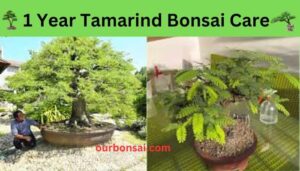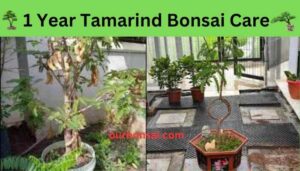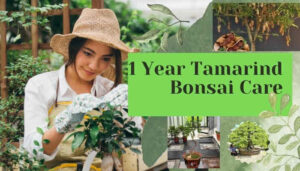Discover the best 1 Year Tamarind Bonsai Care tips with our expert guide for 2025! Learn how to water, prune, and maintain a healthy tamarind bonsai tree. Perfect for beginners, this guide covers essential care techniques to ensure strong growth and beautiful foliage. Start your bonsai journey today!
Table of Contents
ToggleOverview 1 Year Tamarind Bonsai Care: Complete Guide to Tamarind Bonsai Care for Healthy Growth This comprehensive guide delves into the essential aspects of tamarind bonsai care, ensuring that both novice & experienced enthusiasts can cultivate thriving plants.
Starting with a detailed examination of the first-year care routine, the article covers indoor bonsai cultivation, highlighting specific needs for maintaining health & vigor.
Also featured are insights into sourcing quality tamarind bonsai for sale, tips for creating a stunning tamarind bonsai forest, & a step-by-step approach to crafting your own bonsai masterpiece.
And another thing, readers will find valuable information on the lifespan of tamarind trees, the cost of tamarind in the market, & expert advice on how to keep bonsai trees healthy & happy. The guide emphasizes the importance of proper fertilization, suggesting the best fertilizers for optimal growth.
By following this thorough resource, bonsai lovers can nurture their tamarind trees into beautiful, long-lasting specimens.

1 Year Tamarind Bonsai Care
Taking care of a tamarind bonsai involves several key practices. These practices ensure the tree develops beautifully & remains healthy throughout the year.
Watering should be consistent but not excessive. Overwatering can lead to root rot. Ensure the soil retains moisture without becoming soggy. Use well-draining soil for optimal results.
Fertilization is crucial for growth & vitality. Use a balanced fertilizer every four to six weeks during the growing season. Reduce feeding in winter when growth slows.
| Fertilization Schedule | Amount |
|---|---|
| Spring | 1 teaspoon per gallon |
| Summer | 1 teaspoon per gallon |
| Fall | 1 teaspoon per gallon |
Pruning is essential for shaping & promoting growth. Trim branches to maintain an attractive form. Remove any dead or yellowing leaves promptly.
1 Year Tamarind Bonsai Care
Light requirements vary, but tamarind trees prefer bright, indirect sunlight. Placing it near a sunny window is ideal. Rotate the bonsai occasionally to ensure even growth.
- Monitor for pests regularly.
- Keep humidity levels consistent.
- Repot every couple of years to refresh the soil.
Temperature control is also important. Tamarind trees thrive in warm conditions. Keep them indoors if temperatures drop below 50°F.
By following these care tips, your tamarind bonsai will flourish. Commitment & attention will result in a stunning bonsai display.
1 Year Tamarind Bonsai Indoors
1 Year Tamarind Bonsai Indoors can thrive with proper care. This unique plant requires specific conditions to flourish. Place your bonsai in an area with bright, indirect sunlight. Avoid direct sun exposure to prevent leaf burn.
Water the tamarind bonsai consistently, allowing the soil to dry between waterings. Check the soil moisture weekly to avoid overwatering. A well-draining potting mix is essential for healthy growth.
| Care Aspect | Description |
|---|---|
| Light | Bright, indirect sunlight is optimal. |
| Watering | Water when the top inch of soil feels dry. |
| Humidity | Preferably keep humidity levels moderate. |
Fertilize the bonsai every month during the growing season. Use a balanced fertilizer for best results. Pruning is also vital for maintaining shape & size.
- Check for pests regularly, including spider mites & aphids.
- Repot every couple of years to refresh the soil.
- Inspect leaves for any signs of distress or discoloration.
Indoor tamarind bonsais thrive in temperatures between 65°F & 75°F. Protect them from cold drafts & sudden temperature changes. With the right care, these bonsais can be a stunning addition to your indoor space.

1 Year Tamarind Bonsai For Sale
1 Year Tamarind Bonsai offers unique charm for plant enthusiasts. These bonsais thrive with proper care & attention. Their compact size makes them perfect for indoor or outdoor spaces. Each plant showcases the beauty of the tamarind tree in miniature form. You will love their lush green leaves & intricate branches.
When thinking of purchasing, consider their needs. Tamarind bonsais require specific lighting & watering routines. Ensure they get adequate sunlight to flourish. A south-facing window is ideal for growth. Regular watering is essential but avoid over-saturation. The soil should be moist but never waterlogged.
| Care Aspect | Details |
|---|---|
| Light | Bright, indirect sunlight is best. |
| Watering | Keep the soil slightly moist. |
| Temperature | Maintain warm temperatures, avoiding frost. |
Purchasing 1 Year Tamarind Bonsai comes with several benefits. It is an excellent gift for plant lovers. These bonsais are low maintenance yet highly rewarding. Their unique aesthetic adds a touch of nature to homes. Enjoy watching them grow & develop into stunning plants.
- Promotes relaxation & reduces stress.
- Great for small spaces, apartments, or offices.
- Encourages responsibility & care.
Choosing a healthy bonsai is crucial. Inspect for any signs of disease or pests. The foliage should appear vibrant & green. Healthy roots are firm & well-established. Selecting quality plants ensures they thrive in your care. Owning a 1 Year Tamarind Bonsai enriches your living space significantly.
Tamarind Bonsai forest, 1 Year Tamarind Bonsai Care
A Tamarind Bonsai forest creates a stunning visual display. These trees offer unique shapes & forms. Their delicate leaves catch the light beautifully.
They thrive in various climates, making them versatile. A group of Tamarind Bonsai creates an enchanting atmosphere. Each tree tells its own story, contributing to the overall beauty.
Proper care is vital for their health. Tamarind trees love sunlight but appreciate some shade. It’s crucial to keep the soil well-drained yet moist. Overwatering can cause root rot & affect growth. Fertilizing regularly helps maintain vibrant foliage.
Choosing the right fertilizer promotes better growth. Pay attention to its seasonal needs to optimize health.
| Care Aspect | Details |
|---|---|
| Sunlight | Prefers bright, indirect light. |
| Watering | Keep soil slightly moist. |
| Fertilizing | Use a balanced fertilizer every month. |
Creating a miniature forest brings joy & tranquility. Arrange the trees in varying heights for depth. Complement with decorative stones to enhance aesthetics. Use moss for added texture & greenery. Regular pruning keeps the trees tidy & promotes growth.
- Choose the right potting medium for drainage.
- Monitor for pests & treat immediately.
- Regularly check soil moisture levels.
These trees thrive best in warm weather. Protect them during cold nights with covers. Pruning encourages bushier growth & maintains size. Adjust care based on seasonal changes for optimal results.

1 Year Tamarind Bonsai Care | How To Make Tamarind Bonsai Tree?
Creating a Tamarind Bonsai tree is a rewarding experience. Start by choosing a healthy Tamarind seedling. Select a pot with adequate drainage. Use a well-draining soil mix to encourage healthy growth.
Water the seedling regularly to maintain moisture levels. Make sure not to overwater, as this can cause root rot. Place the bonsai in a location that receives plenty of sunlight.
| Watering Schedule | Recommended Frequency |
|---|---|
| Spring | Every 3 days |
| Summer | Every 2 days |
| Fall | Every 4 days |
| Winter | Every week |
Pruning is essential for maintaining shape. Trim the branches to encourage bushy growth. Use sharp, clean shears to prevent damage & disease.
- Monitor for pests regularly.
- Fertilize once a month during the growing season.
- Repot every two years to refresh the soil.
Keep a close eye on leaf color & texture. Yellowing leaves can signal overwatering. Healthy green leaves indicate proper care.
As your bonsai matures, consider wiring the branches. This helps create the desired shape. Remove wire carefully to avoid injury.
With patience & dedication, your Tamarind Bonsai can thrive. Enjoy the process & celebrate each stage of growth.
What Is The Maximum Age Of Tamarind Tree?
The tamarind tree (Tamarindus indica) can live for several decades. Generally, its lifespan ranges from 50 to 150 years. Some individual trees have been reported to live beyond 200 years under ideal conditions. Factors influencing their lifespan include climate, soil quality, & care provided.
Healthy tamarind trees thrive in warm, tropical climates. Proper irrigation & minimal pests are essential for longevity. These trees can grow large & provide shade, fruits, & wood. They are also known for their resilience, able to withstand dry spells.
Over time, a mature tamarind tree may showcase impressive growth. With age, the tree’s bark becomes thick & rugged. The crown becomes expansive, providing habitat for various wildlife species. Thus, the tamarind tree contributes to biodiversity in its surroundings.
| Aspect | Description |
|---|---|
| Climate Requirements | Tropical & subtropical regions are ideal. |
| Soil Type | Well-draining, loamy soils are preferred. |
| Water Needs | Moderate watering, avoiding waterlogging. |
To promote longevity, focus on maintenance. Regular pruning helps sustain a healthy structure. Fertilization during the growing season enhances fruit production. Pest control measures can further prolong the tree’s life.
- Age: 50 to 150 years average.
- Extreme cases: More than 200 years.
- Preferred conditions include high temperatures & well-drained soil.
Ultimately, understanding the tamarind tree’s needs aids in increasing its lifespan. With the right care, you can enjoy its benefits for generations.

How Much Is 1 KG Of Tamarind? | 1 Year Tamarind Bonsai Care
When considering the price of 1 kg of tamarind, factors come into play. The cost varies based on location & availability. Typically, you may find prices ranging from $2 to $6 per kilogram.
Local markets often have lower prices than specialty stores. Organic tamarind generally costs more than regular varieties. Seasonal fluctuations can also affect pricing. Prices might rise during off-peak seasons.
Buying in bulk can lead to discounts. Local growers or farmers’ markets might offer attractive rates. Online purchases may include shipping fees, impacting the overall cost. Tamarind comes in various forms like paste, pulp, or whole pods. Each form can have different price points.
| Form of Tamarind | Average Price per KG |
|---|---|
| Whole Pods | $2 – $4 |
| Tamarind Paste | $4 – $6 |
| Dried Tamarind | $3 – $5 |
Prices can reflect quality & freshness. Sourcing from reliable suppliers is crucial. Seasonal discounts or promotions may lead to better deals. It’s wise to check multiple sources for the best offers.
- Factor in shipping costs when ordering online.
- Explore local farmers’ markets for potential savings.
- Consider organic options if quality is a priority.
Keep these details in mind as you budget for your tamarind needs. Regular price checks can help you stay informed. Enjoy the benefits of using tamarind in your cooking & gardening endeavors.
How Do You Take Care Of A Tamarind Bonsai Tree?
Taking care of a tamarind bonsai tree requires simplicity & attention. Start by selecting the right pot. It should have good drainage. A well-draining soil mix is essential for healthy roots. Use a mixture of akadama, pumice, & organic matter.
Watering is crucial for your tree’s health. Check the moisture level regularly. Water deeply but avoid waterlogging the soil. Tamarind trees prefer a slightly dry environment between watering. During the growing season, water more frequently.
| Season | Watering Frequency |
|---|---|
| Spring | Every 2-3 days |
| Summer | Every day |
| Fall | Every 3-5 days |
| Winter | Every 7-10 days |
Fertilizers provide necessary nutrients. Apply liquid fertilizer every four weeks during growing months. Use a balanced fertilizer to promote healthy leaves & growth.
- Prune regularly to maintain shape & size.
- Watch for pests & treat them promptly.
- Provide full sun exposure for optimal growth.
Repot your tamarind bonsai every two years. This keeps the roots healthy & promotes growth. Choose a slightly larger pot when repotting.
Check for pests like aphids & spider mites. Use insecticidal soap for treatment. Keep leaves clean by misting or gently wiping them.
Lastly, observe the seasonal changes. Adjust care based on temperature & humidity levels. Your tamarind bonsai will thrive with consistent care.

What Is The Maximum Age Of Tamarind Tree?
The tamarind tree (Tamarindus indica) is known for its longevity. Typically, it can live for over 100 years. In ideal conditions, some tamarind trees may even reach 200 years.
Such trees thrive in warm, tropical climates. Proper care significantly influences their lifespan. Healthy soil & regular watering benefit their growth. And another thing, avoiding excessive pruning helps maintain their vitality.
Factors impacting the maximum age include climate, soil quality, & care practices. Here’s a breakdown of the ideal growth conditions:
| Condition | Ideal Requirement |
|---|---|
| Climate | Tropical or subtropical |
| Soil Type | Well-draining, sandy loam |
| Watering | Moderate; avoid waterlogging |
In addition, pest management is vital for health. Regular checks for insects help in early detection. Reducing stressors like drought or overcrowding promotes longevity.
- Plant in full sun for best growth.
- Fertilize during the growing season.
- Mulch to retain soil moisture.
Research indicates that older tamarind trees often have broader trunks. Their expansive root systems contribute to stability & nutrient absorption. Pruning should be minimal to preserve their natural shape.
The maximum age of a tamarind tree is a testament to its resilience & adaptability. With the right care, these trees can thrive for generations. This longevity makes them valuable additions to gardens & landscapes.

How Do I Keep My Bonsai Tree Happy?
Keeping your bonsai tree happy involves careful attention to its needs. Start with proper watering. Water your bonsai when the topsoil feels dry. Make sure to provide adequate drainage to avoid root rot.
Light is crucial for a thriving bonsai. Place it in a location with bright, indirect sunlight. Too much direct sun can scorch the leaves, while too little light can stunt its growth.
1 Year Tamarind Bonsai Care
Humidity plays a key role. Bonsai trees benefit from higher humidity levels. Mist your tree regularly or place it on a humidity tray with water & pebbles.
| Factor | Recommended Care |
|---|---|
| Watering | Water when topsoil is dry, ensuring drainage |
| Light | Bright, indirect sunlight is ideal |
| Humidity | Mist regularly; consider humidity trays |
Fertilizing should be done during the growing season. Use a balanced fertilizer every four to six weeks. This promotes healthy growth & vibrant foliage.
Pruning is essential to maintain shape & vigor. Regular pruning encourages branching & fuller growth. Make sure to use sharp, clean tools for this task.
- Water your bonsai deeply but infrequently.
- Adjust light exposure based on season & tree type.
- Monitor for pests & diseases regularly.
Repot your bonsai every two to three years. This refreshes the soil & provides more room for root growth. Prioritize repotting during the tree’s dormant period.
Lastly, observing your bonsai regularly is vital. Notice changes in leaf color or growth patterns. This helps you adjust care accordingly for overall health.

What Is The Best Fertilizer For Tamarind Trees?
The best fertilizer for tamarind trees plays a crucial role in their growth. Tamarind trees thrive with a balanced nutrient supply. Nutrients such as nitrogen, phosphorus, & potassium are essential.
Choosing organic fertilizers can be beneficial for sustainability. Options like compost & manure promote healthy growth. Chemical fertilizers can provide quick nutrient boosts if used correctly.
Your tamarind tree will flourish with the right fertilization schedule. Start fertilizing in early spring as new growth appears. Continue every six to eight weeks throughout the growing season.
Monitor soil health to determine when additional nutrients are needed. Soil tests can guide fertilizer choice & application rates.
| Nutrient | Importance |
|---|---|
| Nitrogen | Promotes leafy growth & overall health. |
| Phosphorus | Encourages root development & flower production. |
| Potassium | Supports fruit development & disease resistance. |
Consider using slow-release fertilizers to ensure steady nutrition. This helps maintain consistent growth without overwhelming the tree. Liquid fertilizers can also be used for quick absorption. Always follow manufacturer instructions for application rates.
- Organic options promote beneficial microorganisms in the soil.
- Chemical fertilizers may require more frequent application.
- Adjust fertilizer types based on tree age & growth stage.
Pay attention to your tamarind tree’s response to fertilization. Yellowing leaves may indicate a nutrient deficiency. Adjust your fertilization routine as necessary. A healthy tamarind tree will show vibrant leaves & a strong root system. Monitoring & adjusting fertilizer application will ensure optimal growth.
Conclusion
Caring for your tamarind bonsai can be a rewarding experience. By following the steps we’ve discussed, you can help your tree thrive & showcase its unique beauty. Remember to provide the right sunlight, water, & soil for healthy growth. Regular trimming & checking for pests will keep your bonsai in top shape.
Take your time & enjoy the process, as every little effort contributes to your plant’s well-being. With patience & attention, your tamarind bonsai can flourish, becoming a cherished part of your home. Happy gardening, & may your bonsai bring you joy for years to come!
